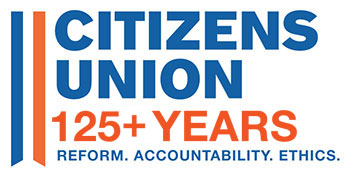Drawing the Line
On April 28th, Citizens Union Foundation with the School of Public Affairs, Baruch College, CUNY hosted Drawing the Line: Redistricting and Non-Competitive Elections in New York State, a half day symposium focused on reforming how the state draws legislative district lines. The symposium brought together civic and business leaders, elected officials and experts in the area of voting reform and voting rights to explore how the current process of redistricting in New York State has impacted voter participation and representation, as well as the formulation and enactment of public policy. It was an opportunity for an open discussion of these issues and to consider ways in which the current method of drawing legislative district lines can be reformed.
Candidates Release Statements Calling For Redistricting Reform at Symposium
All four gubernatorial candidates released statements calling for redistricting reform, including the creation of an independent redistricting commission, at the April 28 event. Thomas Suozzi presented his position in person, while an aide to Eliot Spitzer presented his position and both John Faso and William Weld provided their positions in writing.
To read their statements click on links below:
Thomas Suozzi’s remarks to audience on redistricting reform (PDF 295KB)
Eliot Spitzer’s statement on redistricting reform (PDF 60KB)
John Faso’s statement on redistricting reform (PDF 63KB)
William Welds’s statement on redistricting reform (PDF 63KB)
Symposium materials:
Relevant Research:
Gerald Benjamin, 2004, Reform In New York: The Budget, The Legislature, And The Governance Process
Andrew Gelman and Gary King, 1994, Enhancing Democracy Through Legislative Redistricting
Michael P. McDonald, 2005, Drawing the Line on District Competition
Michael P. McDonald, 2004, A Comparative Analysis of Redistricting Institutions in the United States, 2001-02
New York Public Interest Research Group, April 2006, “Unfair Advantage: New York State’s Redistricting Process.”
- Marvin Overby and Kenneth M. Cosgrove, 2006, Unintended Consequences? Racial Redistricting and the Representation of Minority Interests
Public Policy Institute of California, 2001, “The Effect of Minority Districts and Minority Representation on Political Participation in California.”
Recent Articles:
New York Sun, John P. Avlon Column, April 25, 2006, “Election Reform Negligence”
New York Times, April 21, 2006, “Groups Call for Nonpartisanship in Drawing State’s District Lines“
Los Angeles Times, March 23, 2006, “Redistricting Plan a Long Shot, but a Promise is a Promise“
New York Times, Michael Gianaris Op-Ed, March 5, 2006, “Redrawing the Political Map”
New York Times, November 11, 2005, “For Election Reform, A Heartening Defeat.“
Ed Cook, 2002, A Non-Partisan Approach to Redistricting (Iowa)
The Arizona Republic, Feb. 20, 2001, “Redistricting Effort Already a Flop; Panel Should Resign, Start Over.”
New York State Redistricting Proposals:
Bill A. 5413 Establishes an apportionment commission to create apportionment plans for Congressional and state legislative districts based on decennial federal censuses, which shall be considered by and voted upon by the state legislature; eliminates the legislative task force on demographic research and reapportionment .
Bill A.2540/ S.487 Proposes a constitutional amendment to create a non-partisan five member apportionment committee, four members of which shall be appointed by the majority and minority officers of the legislature and the fifth to be selected by the aforesaid four, to create new legislative districts; requires districts to be as compact as possible; sets standards for establishment of legislative districts.
Bill A.1199/ S.3180 Provides for the establishment of state legislative districts by a nonpartisan commission, having no members of the legislature, pursuant to law; makes the commission’s final apportionment subject to legislative approval.
Additional Information:
Arizona Independent Redistricting Commission
Reforms to Enhance Independent Redistricting: Superdistricts & Single-member District Plus
